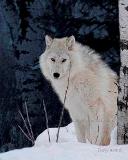|
| VIEW TAKEN FROM MY KAYAK ON ANGLIN LAKE |
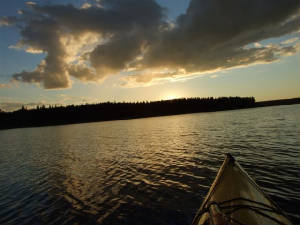
|
Wolves are in general very shy, yet curious animals.
Like most wild animals wolves typically try to avoid coming in contact with humans. Whenever a wild animal starts to
lose its fear of people however through habituation, they may be more prone to approach humans,
human homes, and camping spots.
Wolves that are fed by humans either directly or indirectly
through tossing garbage around areas humans frequent, they are habituating
the animals, and the wolves will then associate food with people. This
may precipitate an attack on humans, by an otherwise naturally shy creature.
Having grown up in wolf /bear country literally, there
were many things we did and still do, in order to help prevent run-ins with wildlife.
AWA is
situated in the country, literally in the middle of a very large forest where bear, wild wolves, and other large predators
cross through on natural routes. Whenever we are out in the bush, we are always
aware of everything around us at all times. We use our ears, eyes, and even smell.
The following are a few tips
to help avoid potentially dangerous conflict, with wolves and other wildlife.
ˇ PLEASE do NOT litter! Throw all garbage into cans
with secure lids. Growing up one of my favorite characters on T.V was an Owl and his slogan of "Give A Hoot Don't Pollute!"
ˇ
Do NOT feed
wild wolves or any other wild animals, even feeding deer can attract wild wolves to your home, as the wolves will follow their
prey (food). Many people are not aware that even wild fox can become extremely aggressive if fed
people food, quite a few fox in our National Park get relocated due to getting TOO familiar with human food.
ˇ
Leave no pet food
outside! I hear MANY stories by other ranchers how they had to shoot a raccoon due to it getting into the cat and dog
food, that was left out. That the animal had become aggressive. This is unfair, it is
almost like setting animals up and taunting them to take the pet food.
ˇ Do
not allow pets (cats or dogs) to be unattended while outdoors, they are easy prey for wild wolves. If you are not with
your dog keep them in a secure pen where they cannot escape to harass wildlife, or draw wildlife like
wild wolves and bears to your doorstep. There are many an acreage dog and cat that goes missing around here, due to
them being allowed to roam freely.
ˇ
Install motion
sensor lights, it may act as a deterrent to scare any wild animals away. Out here in the country where I live
motion sensor lights, aside from yard floodlights are just common sight to see.
I have done a ton of camping
over the years on canoe trips, these were all tips we used and use as a mantra, when in the great outdoors. I learned
the following rules from the time I was a young child.
When Camping Or Simply Out For An Outdoor Wild Adventure :
-
Place any garbage in bear sealed containers, do not have food lying around your campsite
and NEVER in your tent. MANY campsites up north here provide not only bear sealed containers, but also platforms
built up in the trees, a ladder is provided for campers to use to climb up onto the platform to
place sealed containers. Then one simply moves the ladder away when not needed on site, or when walking away from camp
for a while.
-
Cook, wash dishes and store any food items away from your sleeping quarters
-
Suspend
any food items, toiletries like toothpaste, and shampoos,and any garbage in camping bags with attached ropes to hang
out high from tree branches. Wolves can
leap 8 feet straight up into the air so I recommend
the bags suspended quite high.
-
If bringing your dog(s) along camping, but be sure to keep pets close at all times, do NOT allow pets to roam around free unleashed.
Wolves are territorial creatures and will kill any dogs they come across,
especially if harassed. The dog may also lead any
angry wolves straight back to you and your tent.
-
When out on a hike,
we have always clapped our hands saying
something along the lines of "hear bear bear bear" for noise, we also will bang sticks, or
just chat to alert any animals we are in the area. There are also bear bells one can ring when out walking, or place on bikes
when riding to help alert any wildlife.
-
Always be aware of your surroundings when
out in nature, look for signs of bears *scat, clawed up (marked) trees and logs, animal prints, various animal sounds. The
photo I took below while on an excursion shows various prints including bear recently being there..
Listen, Look, and BE AWARE at all times, have fun but keep in mind you are in someone else' backyard, and
it is a wild one. AWA recommends buying some track/signs of wild animal books, to accompany you on any outdoor excursion.
-
Photographers, If
you are out to try and capture the beauty of wild animals through the lenses, please keep in mind to follow
*wild wisdom* rules, keep your distance from ANY wild animal, do not chase after,
or try and get a CLOSER shot. Wild animals whom feel threatened, may suddenly decide you are infringing on their territory
and react out of fear, which can readily turn to fear aggression, resulting in an attack. Depending
on the time of year (breeding season) wild animals go through a natural form of
seasonal aggression, this can make already a potentially dangerous wild animal even MORE so. What we may view as an appreciation
of nature and wildlife through trying to photograph them, and or view them in their natural habitat, could easily
result in unintentioned harassment to the animals. Please respect all wildlife by observing such, on
THEIR terms.
-
Avoid wearing and washing/conditiong your hair with sweet smelling scents, women especially love
to smell *fruity* but bears have amazing sniffers and may sniff YOU out!
-
Be Aware when you eat something not to leave behind remnants of that meal, or any packaging from that food. Smells
of food (even from a wrapper) can draw in a variety of wild animals, which is another good reason to not eat on the go. Some
people like to hike and munch granola bars at the same time, you are leaving behind crumbs as you eat and walk much like hansel
and gretel, which could entice an animal to follow your tracks!
| PHOTO OF VARIOUS ANIMAL PRINTS |

|
| BE AWARE WHEN OUT AND ABOUT; I TOOK THIS PHOTO WHILE ON A TREK, THERE ARE BEAR TRACKS HERE |
Wolves
are VERY territorial animals, they will kill other other wild canids such as coyotes and other wolves that cross into their
marked/claimed boundaries. The following picture shows wolf scratching/marking made by a wild wolf (wolves) in the area.
(I took this picture on an old logging forest trail in our National Park, where bear, moose, and wolves commonly cross
through.) You will also notice some urine (marking territory sign as well.) These scratches from what I could tell
were not really recent, but looked to have been made within a couple weeks, and there is lots of wolf scat and prints in the
area, among other wild life tracks.
| Wolf Markings/Scratches |

|
Wolves showing aggression will show
any number of signs such as standing ground with a direct hard stare, accompanied by erect ears held forward, or ears
flattened back, there may or may not be an accompanying growl, hackles may or may not be raised. If
you come in contact with a wolf and it does not flea when it sees you, or at least, does not advance straight towards
you, and is only showing simple curiosity, before departing on it's natural way, I would simply advise
caution, and not to try and approach the animal.
Respect the wolf on their terms.
This could be an amazing experience to take in, and treasure.
Through captive observation, and through personal experiences,
I have witnessed when a wolf is highly agitated, how they may full out run at the person/object they feel threatened by, and
start pawing the ground like a bull. They may go down as if in a play bow and come up with both feet scratching,
and do this several times aggressively.
This is a threatening gesture, and although highly unnerving, the wolf is giving a warning
to back away, this warning may or may not be followed by an attack, it depends on the situation/circumstances/the
animal itselfs personality.
In all liklihood if such a thing happens to you simply
back away slowly, do not turn your back and run. If the wolf continues to approach raise your
hands above your head and wave them while making lots of intimidating noises, If you have access to any large tree branches
on the ground, quickly pick such up and proceed to back away slowly, making loud noises and waving the branch back and forth.
This stick could also serve as a way to offset any potential bites.
If an
attack occurs (although very rare,) and the wolf does manage to get on top of you, immediately your focus should
be to try and force your fist down the animals throat to grab ahold of the windpipe, squeeze this till it renders
the wolf unconscious. If you have a stick /branch in hand use the stick to thwart bites, and to force the stick
down the wolf's throat. If a wolf has a hold of your arm or leg do NOT get into a tug of war, and try and pull
away/back in the opposite direction as will be your natural inclination/initial response, instead go in the direction
of the wolf pull, a wolf's jaw pressure is designed to clamp on securely you will only cause more damage to your
physical person. If you go with/in the direction of the wolf's pull there may be a fraction of a second
where the wolf may loosen it's grip, just enough to get a better hold on you, SEIZE THAT moment to pull away and do what you
have to do to survive.
This will be no time to lose thought and flail around in a panic, as this could give
the wolf an even better opportunity to inflict more harm, this could also incite the wolf even more, as they are highly reactive
animals towards excitement and panic.

Recommended
outdoor adventure items (Reading/Misc)
The following items are all taken
from my all time favorite place to shop for my own facility, Acorn Naturalists so enjoy your visit!

TRACKING AND THE ART OF SEEING, How to Read Animal
Tracks and Sign. Rezendes. Identify which animal left track, sign, scat, browse or claw marks. Recognize different types of
animal trails, dens, shelters and habitats. Learn about the subtle differences between similar marks as well as how to identify
tracks under difficult conditions. This recently reprinted guide shows how to identify 50 North American mammals. Over 300
glossy color photographs for both the beginning and seasoned tracker
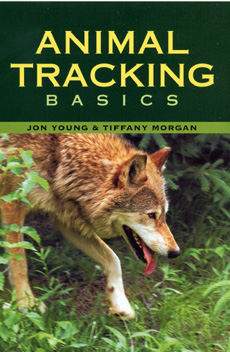
ANIMAL TRACKING BASICS. Young, Morgan. Successful tracking
involves more than just identifying scat, tracks or other indicators. Studying how animals behave—how they find food,
travel and rest must also be factored into the tracking equation. Learn how to develop awareness of environmental factors
that are essential to successful tracking. Learn how to determine the age of tracks and scat, map track patterns, keep field
notes and make casts. Whether a novice or advanced tracker, this book helps you refine your field tracking skills
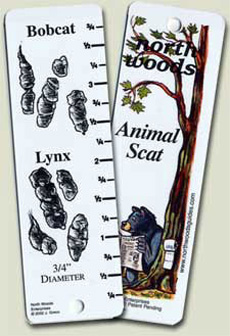
ANIMAL SCAT KEYCHAIN IDENTIFICATION GUIDE. This waterproof
plastic card guide features 24 different animal scat from common North American animals. Each tag measures just 1-1/4”
x 4”, bound together with a ball chain. Cards fan out easily for quick identification while allowing for side-by-side
comparisons of similar scat such as deer and moose. Back side contains interesting facts about where the animals live, what
they eat, and size comparisons. Cards feature ruler marks and are very lightweight

THE ENCYCLOPEDIA OF TRACKS AND SCATS. McDougall. Comprehensive
guide to identifying the tracks and scats of all trackable animals of the United States and Canada. With ample use of photographs
and line drawings, this book teaches basic identification skills along with interpreting and understanding animal behavior
and diet from tracks and scats. This volume includes all information necessary for professional biologists, field researchers,
and wildlife personnel to readily identify their subject matter, but is also a handy, easily understandable reference for
amateur and hobbyist trackers. Detailed discussions on collecting data from the field along with a list of essential supplies
for a field kit

THE COMPLETE TRACKER, Tracks, Signs, and Habits of
North American Wildlife. McDougall. If you have tried tracking, you know that one rarely finds “textbook” tracks
in soft damp clay. This guidebook offers tips for tracking in sand, snow, vegetation and even over rock. Teaches how to determine
stride, straddle and gait which can tip you off to what “mood” the animal is in. Learn to age tracks, scat, scent,
bedding and browse signs. Sketches and range maps for 45 North American mammals
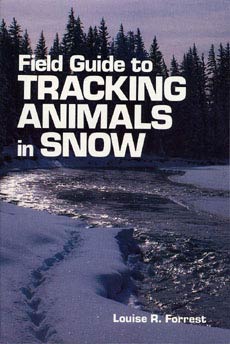
FIELD GUIDE TO TRACKING ANIMALS IN SNOW. Forrest. Many
animals conduct business as usual in the winter, as shown by the tracks, sign, and scat that they leave behind. All animals
leave tracks in the snow - the problem is that snow does not “copy” tracks the way soil does. This guide concentrates
on sketching tracks as you would find them in the snow
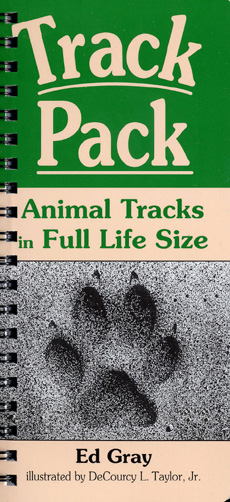
TRACK PACK, Animal Tracks in Full Size. Gray. Spiral
bound hip pocket (3” x 7”) guide featuring life-size renderings of the tracks of 38 different North American animals.
Also shows sets of tracks for pattern identification. Includes range maps for all species.

PAJARO “GRANDE” FIELD BAG. Extra-roomy
black field bag features a main pocket that zips shut for waterproof protection of up to several field guides, including Sibley
guides. Also features unique side-zippered pocket that holds full-sized binoculars. Four additional pockets can house maps,
checklists, personal items, valuables and pens. Elasticized side pocket holds a water bottle, cell phone or sunglasses. Available
as a shoulder bag (with a belt loop) or as a waist pack. Size (when empty) = 7.5” x 10” x 3”. Shoulder pack
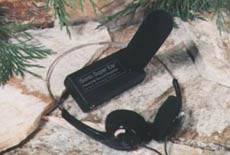
SUPER EAR, Personal Sound Enhancer. What binoculars
did for vision, this product does for listening. Produces an adjustable 50 decibel gain on sounds picked up from its multi-element
high sensitivity microphone. With only a single AAA battery, this lightweight device produces amazing results. On a recent
camping trip, we were able to hear woodrats rustling through the leaves several hundred feet away! Use to amplify bird sounds
(can be clipped to binoculars), feeder sounds, or frogs at night. Comes complete with high quality stereo headphones, clip
and Velcro attachments, AAA battery, instructions and suggestions for use. Begin hearing things you’ve never heard before!
One year warranty.

ACORN NATURALISTS FIELD BINOCULAR, 8x by 21mm. This
eight power by 21mm binocular features fully-coated lenses to reduce glare and produce crisp, bright images. Lenses provide
unsurpassed infra-red and ultra-violet protection, reducing eye strain and improving image contrast. Easy to adjust center
focus knob with an independent right diopter to adjust for any differences in vision from one eye to the other. Roll-down
eyecups for eyeglass wearers. Focuses from infinity down to 9 feet with a field of view of 379 feet at 1000 yards. Includes
pouch case and wrist strap (many prefer to keep these smaller binoculars in pockets to protect them and also to keep them
from flopping around when one bends over or jogs, as is the case when using neck straps). Perfect binocular for all, from
novice beginners to advanced users. Forest green color is easy on the eyes - no flashy finishes that can scare away wildlife
|
